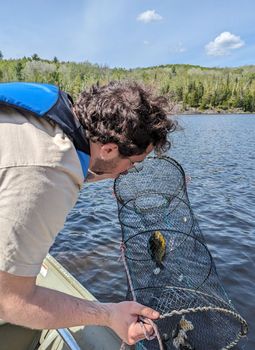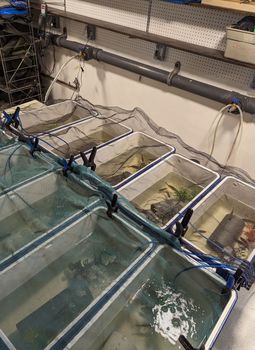This summer, Vincent Mélançon, a Ph.D. student supervised by professors Sandra Ann Binning and Sophie Breton of UdeM's Department of Biological Sciences, is spending his time fishing on three lakes in the vicinity of the Station de biologie des Laurentides (SBL), Université de Montréal's biological research station in the Laurentians. And his catch is supplying him with plenty of food-food for thought, that is!
From May 20 to August 20, Mélançon is living and working at the SBL to study a single creature: the sunfish.
Depending on the lake they live in, sunfish can be infested with one of two types of flatworms: cestodes or trematodes. Like many parasites, cestodes and trematodes are increasing in number and virulence as a result of climate change.
"My goal is to learn how these parasites reduce the fish's oxygen uptake, which is to say its energy production," Mélançon explained.
Three lakes, three ecosystems
Sunfish are a native species found in many Quebec lakes, including the three where Mélançon is casting his net.
The specimens he has collected show that the sunfish in Lac Triton are not infected with flatworms, those in Lac Croche have a moderate level of infestation, and those in Lac Cromwell a high level.
Why the difference? "In general, for a parasite to infest an ecosystem, there have to be several hosts available," Mélançon replied. "There are three types of hosts around the SBL site: copepods and snails are one, sunfish are another, and fish-eating animals such as smallmouth bass and the great blue heron are the third."
One of these three types of hosts is not present in Lac Triton, which explains why its sunfish are free of parasites.
Black spot disease: a cyst inside a cyst
The cestode, also known as the bass tapeworm, is a flatworm that infests the digestive system of fish, while the trematode causes black spot disease.
"The trematode penetrates the fish's muscles and forms a cyst to protect itself," Mélançon explained. "The fish's immune system forms a cyst to protect itself in turn, and through melanization this creates a black spot."
It's easy to see when a sunfish is infested with trematodes because black spots appear on its body. "This is a big plus because it means we can see the extent of the infection without having to euthanize the fish," Mélançon pointed out.
For his research, Mélançon needs to keep his specimens alive in order to observe how the presence of parasites interferes with their oxygen consumption.
He begins by capturing infected and uninfected fish, noting their physiology and measuring their oxygen uptake. He then places them in a cage and submerges it in an infested lake. The uninfected fish become infected and he then takes the same measurements again.
Home-made solutions
Mélançon has three student trainees from the Biological Sciences department working with him, undergraduates Alexandre Aspirot and Enora Lahaye, and Master's student Liana Fortin Hamel. Together, they have created an ecosystem using an assortment of materials.
"We used coolers instead of aquariums because it's easier to control the water temperature and they're easier to transport," said Mélançon. "We then assembled an array of pipes, water heaters, chillers and pumps and created small acrylic respirometry chambers to circulate the water. The oxygen concentrations are recorded and the data transmitted to the computer via fibre-optic cables."
They also applied heavy-duty tape and silicone caulking. "I feel like I've earned a diploma in plumbing too!" Mélançon said with a laugh. For the fishing expeditions, they used waterproof gear and mosquito nets to keep the bugs away.
Differences between fish populations: Hypotheses to be tested
Preliminary results suggest that the physiology of sunfish populations differs depending on the degree of infestation in their lake.
Mélançon recently finished extracting and analyzing the data for the first chapter of his thesis and found that "at the level of the mitochondrion-the cell's energy-producing component-the populations have different metabolisms and sometimes different responses to infection. This would suggest that different populations are either more or less susceptible or more or less responsive to parasite damage."
Mélançon has some hypotheses about why this might be but they have yet to be tested.
"There is a range of possible trade-offs in terms of fish physiology," he suggested. "For example, a slightly infested fish might 'choose' to fight off the parasites [through its immune system] while a heavily infested fish's defence might be to increase its reproduction."
Another possibility is a struggle between the parasite and the host to control the behaviour of the fish.
"Parasites can sometimes change an animal's behavior," said Mélançon. "We know that an infested fish sometimes migrates towards warmer currents, presumably to neutralize the parasite, but this makes it more vulnerable to predators. Is the parasite dictating the behaviour or the fish? We still don't know."










